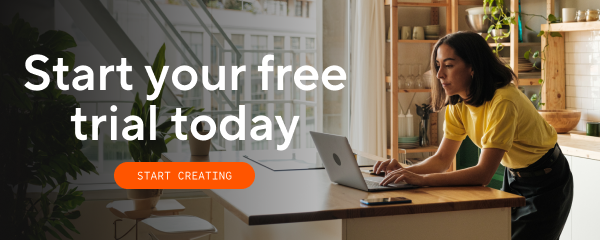What you'll find in this blog post:
- Set up the foundation first – Choose an email service provider, integrate signup forms on your website, and create valuable lead magnets that solve specific problems for your audience.
- Grow through genuine value – Use workshops, behind-the-scenes content, collaborations, and content upgrades to attract subscribers who actually want to hear from you, not just collect random emails
- Stay consistent over perfect – Send regular newsletters (weekly/bi-weekly) focused on subscriber value, track engagement over vanity metrics, and remember that 1,000 engaged subscribers beats 10,000 inactive ones
More tips are below!

Starting an email newsletter from scratch can feel like throwing a party where nobody shows up. You're putting yourself out there, sharing valuable content, and… crickets.
But over the last year, we've learned that building an engaged email list isn't about complicated funnels or sleazy sales tactics.
It's about providing genuine value to people who actually want to hear from you.
If you're ready to build a newsletter that people actually look forward to reading (and that brings real results to your business), this post is for you.
Why Email Marketing Still Matters (Spoiler: It's Not Going Anywhere)
Before we dive into the how-to, let's talk about the why.
Social media algorithms are unpredictable. One day, your post reaches thousands of people, and the next day it reaches twelve. (And one of those twelve is your mom.)
But email? Email is different. When someone gives you their email address, you have a direct line to them. No algorithm decides whether your content gets seen.
Plus, email marketing has an average ROI of $42 for every $1 spent. That's… really good. Like, really, really good.
Here's what a strong email list can do for your business:
- Drive consistent traffic to your website
- Generate leads and sales on autopilot
- Build deeper relationships with your audience
- Give you a reliable way to share new offerings
- Create a community around your brand
The Foundation: What Systems do You Need Before You Start Growing
Let's get the tech stuff out of the way first, because you can't build a house without a foundation.
Email Service Provider (ESP)
You need a platform to send your emails. Here are our top recommendations:
Flodesk – Beautiful design templates, easy to use, great for creatives who want their emails to look as good as their websites. Flat rate pricing means you won't get penalized for growing your list.
Kit (formerly ConvertKit) – Built for creators, with excellent automation features, great for segmenting your audience. Pricing scales with your list size.
Mailchimp – Good starter option, free plan available, lots of integrations. Can get expensive as you grow.
- Bdow for advanced pop-ups and lead capture
- Canva for creating lead magnet graphics
- Calendly for booking strategy calls mentioned in newsletters
Website Integration
Your Showit website is going to be your best tool for growing your email list. You'll want to add signup forms in strategic places:
- Footer of every page
- About page
- Blog post sidebars
- Pop-ups (but use them strategically!)
- Dedicated landing pages for lead magnets
Here's how to embed a newsletter signup on your Showit website:
- Create your signup form in your ESP
- Copy the embed code
- Add an embed element to your Showit page
- Paste the code
- Style it to match your brand
(Pro tip: Make sure your signup forms look intentional, not like an afterthought!)
The Magnet Strategy: What Makes People Actually Want to Subscribe
Nobody wakes up thinking “I hope someone asks for my email address today!” You need to give people a compelling reason to join your list.
Lead Magnet Ideas That Work:
For photographers:
- “Posing guide for couples who hate being photographed”
- “Timeline template for stress-free wedding days”
- “Location scouting checklist”
For designers:
- “Brand color psychology cheat sheet”
- “Client onboarding email templates”
- “Design brief template”
For coaches:
- “Goal-setting workbook”
- “30-day content calendar”
- “Discovery call script”
What makes a lead magnet irresistible:
- Solves a specific problem
- Provides immediate value
- Is easy to consume (no 50-page PDFs!)
- Relates to your paid offerings
- Has a clear, benefit-focused title
Beyond Lead Magnets: 7 Ways to Attract Subscribers
#1 – Workshop or webinar promotion
Host a free workshop on a topic your audience cares about. Promote it on social media and require email signup to attend. Even if people can't attend live, they'll want the replay.
#2 – Newsletter content teasers
Share snippets of your newsletter content on social media with a “read the full post in this week's newsletter” call-to-action. Make people feel like they're missing out on the good stuff.
#3 – Behind-the-scenes access
People love feeling like they're getting exclusive insider information. Offer behind-the-scenes content, early access to new offerings, or subscriber-only updates.
#4 – Collaboration and cross-promotion
Partner with other creators in your industry for newsletter swaps, joint workshops, or collaborative lead magnets. You'll tap into each other's audiences.
#5 – Website exit-intent pop-ups
Set up a pop-up that appears when someone's about to leave your website. Make it valuable, not annoying: “Before you go, grab our free client communication templates!”
#6 – Content Upgrades
Create specific lead magnets for your most popular blog posts. Reading about website design? Offer a design checklist. Reading about client communication? Offer email templates.
#7 – Social proof and testimonials
Share testimonials from current subscribers about how your newsletter has helped them. Social proof is powerful!
The Content Strategy: What to Actually Send Once People Subscribe
Growing your list is only half the battle. You need to keep people engaged so they don't unsubscribe.
Newsletter content that keeps people subscribed:
- Behind-the-scenes of your business
- Case studies and client success stories
- Industry tips and tutorials
- Personal stories and lessons learned
- Exclusive offers and early access
- Curated resources and recommendations
How often should you send newsletters?
Consistency matters more than frequency. Whether you send weekly, bi-weekly, or monthly, stick to your schedule. We recommend starting with bi-weekly—it's manageable for you and not overwhelming for subscribers.
What about newsletter drip campaigns?
Consider creating a welcome series that new subscribers receive over their first few weeks. This helps them get to know you and your value before they join your regular newsletter rotation.
Ingrid Urena, one of our Showit Design Partners, creates seasonal drip campaigns that nurture new subscribers with her best content. “It's like giving them a greatest hits album instead of starting from wherever I happen to be that week,” she says.
Days 1-30: Foundation Phase
Days 1-30: Foundation Phase
- Choose and set up your email service provider
- Create 1-2 lead magnets
- Add signup forms to your website
- Start sending weekly or bi-weekly newsletters
- Set up basic automation (welcome email, lead magnet delivery)
Days 31-60: Growth Phase
- Create content upgrades for your top blog posts
- Host your first workshop or webinar
- Start collaboration outreach
- Add exit-intent pop-ups to your website
- Create a dedicated newsletter landing page
Days 61-90: Optimization Phase
- Analyze what's working and double down
- Create additional lead magnets for different audience segments
- Set up more advanced automations
- Start planning your next workshop or collaboration
- Survey your subscribers to learn what they want more of
Common Mistakes That Kill Newsletter Growth
Mistake #1: Making it about you. Your newsletter should focus on what's valuable to your subscribers, not what you want to promote.
Mistake #2: Inconsistent sending. If you say you'll send weekly emails, send weekly emails. Inconsistency erodes trust.
Mistake #3: No clear value proposition. People should know exactly what they'll get by subscribing to your newsletter.
Mistake #4: Boring subject lines. We covered this in our last post, but it bears repeating: your subject line determines if your email gets opened.
Mistake #5: No calls to action. Every newsletter should tell readers what to do next, whether that's reading a blog post, checking out a service, or replying with questions.
Measuring Success: What Numbers Actually Matter
Don't get caught up in vanity metrics. Here's what to track:
Open rates: 20-25% is good for most industries. Click-through rates: 2-5% is typical
Unsubscribe rates: Under 2% is healthy. List growth rate: Aim for 5-10% monthly growth
Revenue per email: Track how much business your newsletter generates
Remember: 1,000 engaged subscribers is better than 10,000 people who never open your emails.
Ready to Start Growing? Your Next Steps
Building an email list doesn't happen overnight, but it's one of the most valuable things you can do for your business. Start with one strategy from this post and implement it fully before moving on to the next.
Your future self (and your business) will thank you for starting today instead of waiting for the “perfect” moment.
Once you’re in your newsletter groove and you’re excited about staying consistent with it, we’ve got you! Check out our deep dive into newsletter content planning, because once you have those subscribers, you'll want to make sure you're sending them content they actually want to read!
FAQ's
Getting Started:
- Q: How much does it cost to start an email newsletter? A: You can start for free with most platforms (Mailchimp offers a free plan), but expect to pay $10-50/month as you grow depending on your subscriber count.
- Q: How long does it take to see results from email marketing? A: You can start seeing engagement within the first month, but building a substantial list typically takes 3-6 months of consistent effort.
Technical Questions:
- Q: Which email platform is best for Showit websites? A: Flodesk integrates beautifully with Showit and offers flat-rate pricing, while Kit (ConvertKit) has the best automation features for creators.
- Q: How many signup forms should I have on my website? A: Start with 3-4 strategic placements: footer, about page, blog sidebar, and one pop-up. Too many can overwhelm visitors.
Content & Strategy:
- Q: What if I don't have anything interesting to write about? A: Share behind-the-scenes moments, client success stories, industry tips, or curated resources. Your daily work experience is more valuable than you think.
- Q: How do I know if my lead magnet is working? A: Track your conversion rate – if less than 2-3% of website visitors are signing up, your lead magnet may need improvement.
- Q: Should I buy email lists to grow faster? A: Never. Purchased lists have terrible engagement, can get you marked as spam, and violate most email platform terms of service.
Performance & Growth:
- Q: My open rates are low – what's wrong? A: Focus on subject lines, sender name recognition, and sending consistency. Also check if you're ending up in spam folders.
- Q: When should I start segmenting my email list? A: Once you have 500+ subscribers or offer multiple services, start segmenting based on interests, purchase behavior, or demographics.

